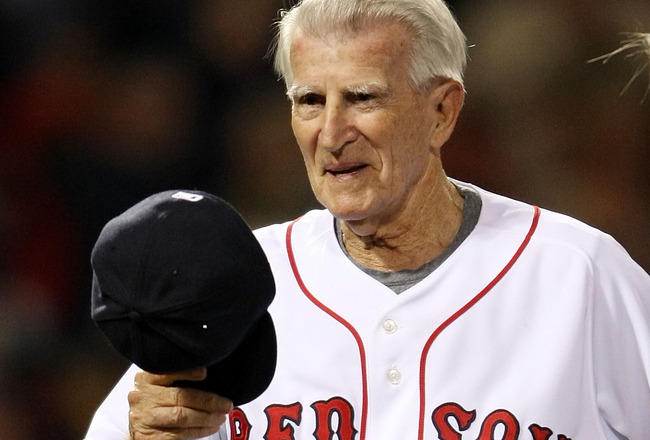John Michael Paveskovich was born on September 27, 1919, in Portland, Oregon. He wasn't of the first wave of ballplayers who left the Pacific Coast, and the Pacific Coast League, for what PCL fans then called "the Eastern leagues," rather than "the major leagues." That wave included Yankee legends Joe DiMaggio, Lefty Gomez, Frank Crosetti and Tony Lazzeri, plus Washington Senators shortstop/manager Joe Cronin, St. Louis Cardinals outfielder Chick Hafey, and Cincinnati Reds catcher Ernie Lombardi -- all from San Francisco and its environs.
(There had been Pacific Coasters in the majors before, notably Chicago Cubs first baseman/manager Frank Chance and Detroit Tiger outfielder Harry Heilmann, but they were few and far between.)
Rather, he was of the second wave, which included another Yankee legend, Los Angeles' Joe Gordon. The Boston Red Sox dove into this wave, purchasing Cronin, and signing Pesky, Joe's brother Dom DiMaggio, Los Angeles native Bobby Doerr, and a skinny kid from from San Diego named Ted Williams.
By 1938, these purchases by Red Sox owner Tom Yawkey had brought the Red Sox to as high as 2nd place in the American League for the 1st time in 20 years. But the Yankees always seemed to be in the way. Pesky reached the majors in 1942, one of several season in this stretch in which the Yankees finished 1st and the Red Sox finished 2nd. He batted .331, and led the AL in hits with 205. Had there been a Rookie of the Year award at the time, he probably would have won it.
He spent the next 3 years with a more important team, the U.S. Navy -- as did his opposite number with the Yankees, Phil Rizzuto. While "Who's better, Rizzuto or Pesky?" didn't have quite the same resonance as the oft-debated question of Joe DiMaggio and Ted Williams, or later debates about Thurman Munson and Carlton Fisk, or Derek Jeter and Nomar Garciaparra, it was a good question. While they were out, Lou Boudreau of the Cleveland Indians was the best shortstop in the AL.
But when the Scooter and Pesky came back, it was a good debate. In that 1st season back, 1946, the Sox finally won their 1st Pennant since 1918, winning 104 games. But they lost the World Series to the St. Louis Cardinals.
Game 7 was tied 3-3 in the bottom of the 8th, and with Harry Walker at bat, Enos Slaughter took off from 1st base. Walker hit the ball to center field, where Dom DiMaggio should have been playing, but he'd injured himself sliding earlier. Leon Culberson, a much less experienced outfielder, bobbled the ball, and Slaughter figured he could score all the way from 1st. Pesky took Culberson's throw, and fired in to Sox catcher Roy Partee, but it was too late. Slaughter scored easily.
For decades, Sox fans, possibly lured into saying so by the Boston media, claimed "Pesky hesitated" or "Pesky held the ball." Interviewed for Boston Globe columnist Dan Shaughnessy's book The Curse of the Bambino in 1989, Pesky said, "Even now, people look at me like I'm a piece of shit."
I've seen the film of the play known as "The Mad Dash" many times. Pesky played it perfectly. And even if Culberson had also done so, I think Slaughter would have scored. Let's not forget that the Cards were in their 4th World Series in the last 5 seasons. They were the more experienced team. They knew what they were doing. They were, for the 3rd time in those 4 tries, worthy World Champions.
That was as close as the Ted Williams-era Red Sox got to a title. They lost a 1-game Playoff for the Pennant to Boudreau's Indians in 1948. In 1949, they came from 12 games behind the Yankees to take 1st, but lost the last 2 games of the regular season and the Pennant to the Yankees. They were in the race again in 1950 and '51, but that would be it until the club's "Impossible Dream" season of 1967 -- by which point the only holdovers were Doerr as 1st base coach and pitcher Mel Parnell as broadcaster.
Pesky was traded to the Detroit Tigers in 1952, and finished with the Washington Senators in 1954. His lifetime batting average was .307, his OPS+ 107. He finished 3rd in the AL Most Valuable Player voting in 1942 and 4th in 1946.
On Baseball-Reference.com's Hall of Fame Monitor, where a "Likely HOFer" is at 100, Pesky is at 71; on its Hall of Fame Standards, where the "Average HOFer" is at 50, Pesky is at 33. It's unlikely he'll ever join his shortstop contemporaries Rizzuto, Boudreau and Pee Wee Reese of the Brooklyn Dodgers in the Hall of Fame.
Pesky was actually in the Yankee organization briefly, playing and coaching for the club's top farm team, the Denver Bears of the American Association, in 1955. He later coached with the Red Sox, managing them briefly in 1963-64, and again as a caretaker in 1980. His work in spring training helped groom many later stars, including his replacement as the greatest shortstop in Sox history, Nomar Garciaparra.
His legacy is election to the Sox' team Hall of Fame, the retirement of his Number 6, and the naming of the right field foul pole at Fenway Park "Pesky's Pole," although the story that Parnell told of Pesky wrapping a home run around it to win a game for Parnell is bogus.
His last public appearance was this April, at the Fenway Park Centennial. With his death, the only surviving Red Sox players from that Game 7, October 15, 1946, 66 years ago, are 2nd baseman Doerr and pitcher Dave "Boo" Ferriss. Surviving from the Cardinals are Stan Musial, Red Schoendienst and Joe Garagiola.
UPDATE: Pesky was buried in Swampscott Cemetery in the Boston suburb of Swampscott, Massachusetts.

Good tribute, I heard Joe Garagiola doing the D-Backs game Sunday afternoon.
ReplyDelete